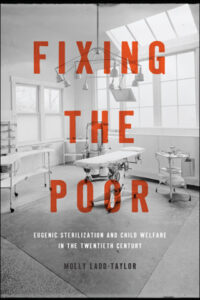 In preparation for an upcoming review of Prof. Paul Lombardo’s new updated edition to his 2008 examination of significant legislation and legal rulings involving eugenic sterilization in the United States, Three Generations, No Imbeciles; Eugenics, the Supreme Court, and Buck v. Bell, I have been spending time becoming better informed about the history of eugenics – both internationally from its beginnings, and as it was practiced in the U.S. during the early twentieth century. As part of this, I happened upon Prof. Molly Ladd-Taylor’s 2017 book Fixing the Poor; Eugenic Sterilization and Child Welfare in the Twentieth Century.
In preparation for an upcoming review of Prof. Paul Lombardo’s new updated edition to his 2008 examination of significant legislation and legal rulings involving eugenic sterilization in the United States, Three Generations, No Imbeciles; Eugenics, the Supreme Court, and Buck v. Bell, I have been spending time becoming better informed about the history of eugenics – both internationally from its beginnings, and as it was practiced in the U.S. during the early twentieth century. As part of this, I happened upon Prof. Molly Ladd-Taylor’s 2017 book Fixing the Poor; Eugenic Sterilization and Child Welfare in the Twentieth Century.
While Prof. Lombardo’s book is decidedly focused on a national level of policy and practice in the United States, Prof. Ladd-Taylor’s is centered on the activities of the states and counties, particularly those of the state of Minnesota. Through this, the reader is presented with the remarkable scale of sterilization laws, their variation across states, and the span of time over which they were in force (those of my own home state of Oregon were in place until 1983).
It must be noted that Prof. Ladd-Taylor, like many – if not indeed most – recent authors whose works I’ve read on the subject of eugenics, does occasionally seem to allow her personal opinions to slip into the book (it is to be granted, given how significantly many societal norms and mores have changed in the U.S. since the early twentieth century, that such once frequently, if not in fact broadly, accepted practices as legally enforced sterilization of those then deemed to be a detriment to or burden upon the society are difficult subjects to research, assess, and present with absolute objectivity today), however the facts are nevertheless clearly presented, and the value of the book as both a portrait of a time and place, as well as a source of information through which to deepen one’s understanding of the larger subject, is well founded.
If you enjoyed reading this, please consider signing up for The Well-read Naturalist's newsletter. You'll receive a helpful list of recently published reviews, short essays, and notes about books in your e-mail inbox once each fortnight.
